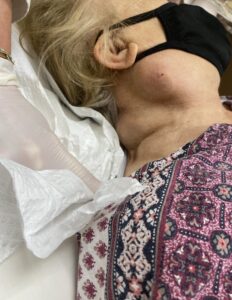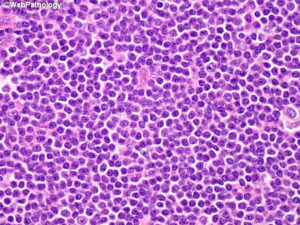
By Celina M. Nadelman, M.D.
A 78-year-old woman walks into clinic. The first thing I notice is her neck lymph nodes. It is enlarged by several massive lumps in the neck, with the right larger than the left. She said she did not really notice them until possibly a few months ago. She hasn’t been herself lately, as she had been mourning the death of her daughter.

Patient with Massive Neck Lymph nodes
I ask the usual questions during the interview phase of the history and physical exam. At the physical exam, the lymph nodes in the neck feel slightly hard to the touch but are non-tender. Ultrasound at the time showed several masses, all stuck together, extending from her ear down to her clavicle. The findings raised suspicion for lymphoma neck or other causes involving lymph glands that are part of the immune system.
I clean and numb the area with a local anesthetic. I then perform an ultrasound-guided fine needle aspiration biopsy of the neck lymph nodes. In addition to making my usual smears, I put some of the biopsy material in special pink fluid, called RPMI. It is a fluid that helps cells stay alive and healthy. That material goes to another lab for a specialized test called Flow Cytometry, which evaluates white blood cells and their surface markers.
I take one of the slides and stain it with a quick 3-step stain and look under the microscope.
What I see is a sea of small dark round cells, lymphocytes, that look like soccer balls filling a stadium. The pattern suggests abnormal lymph glands activity, a common symptom seen when lymphoma spreads to lymph nodes in areas like the neck, armpits, or groin.
In the next few days, the report from the flow cytometry confirms what I had suspected from my microscopic analysis. The patient has CLL/SLL, chronic lymphocytic leukemia/small lymphocytic lymphoma a type of non-Hodgkin lymphoma that involves white blood cells and often starts in lymph nodes in the neck.

Slide of CLL/SLL
What is CLL/SLL?
CLL/SLL is a cancer of immune system cells, called B cell lymphocytes. It can be found mostly in lymph nodes (lymphoma lump) or in the blood, spleen, and bone marrow (leukemia). It is known as an indolent lymphoma as it is usually slow growing, and many patients do not even have any symptoms of lymphoma. Sometimes it is picked up by a routine blood exam at the yearly physical. Many do not even need to be treated for a while.
Occasionally, patients notice shortness of breath, weight loss, or swelling in nodes in the neck and other regions like the groin. These can be early signs of cancer affecting lymph glands or nearby blood vessels.
Causes and Risk Factors
Causes and risk factors are largely unknown, but this is a lymphoma or leukemia that occurs in older people (average 65 years), with a slight male predominance. A family history of Hodgkin lymphoma or types of lymphoma may increase your chances of developing this type of malignancy.
Treatment and Prognosis
After a diagnosis of lymphoma in the neck, tests are performed to see how advanced and how far the cancer spreads to lymph nodes or other organs such as the spinal cord or blood vessel regions. CT scanning is often used to detect how widespread the disease is and identify other common symptoms related to lymphoma neck.
Leukemia is not staged as blood courses throughout the body. Depending on the stage directs the type of treatment. As mentioned, one treatment option is “active surveillance”, or watchful waiting. The patient will be monitored to see if any symptoms of lymphoma arise or if the lymphoma lump has progressed.
As the lymphoma advances, different types of treatment may be given, such as chemotherapy, monoclonal antibodies, targeted therapy, radiation, and bone marrow transplant.
The prognosis of CLL/SLL lymphoma is good, with many patients living without need for treatment. According to the National Cancer Institute, 83% of patients survive 5 or more years after diagnosis, showing how this type of lymphoma is often manageable even when lymph nodes in neck cancer are involved.



